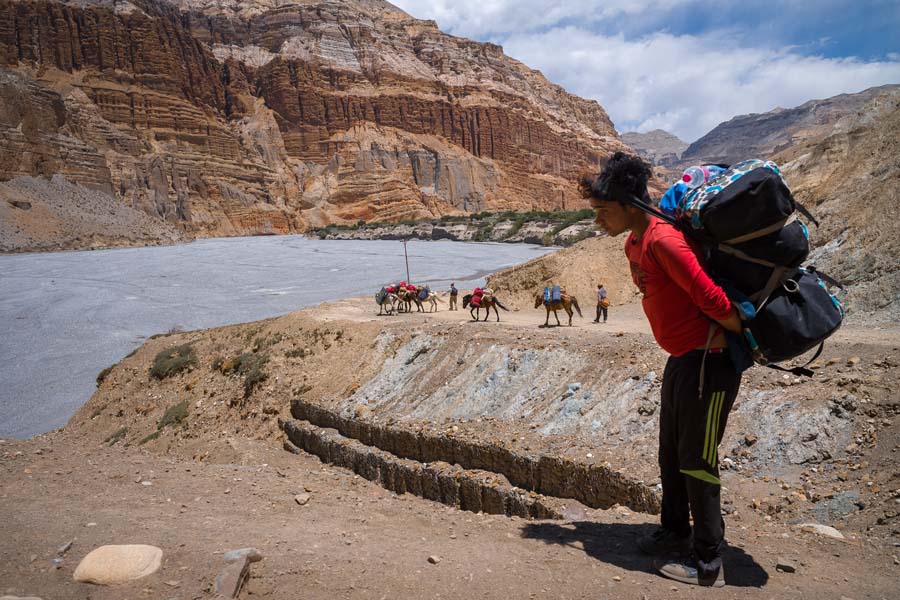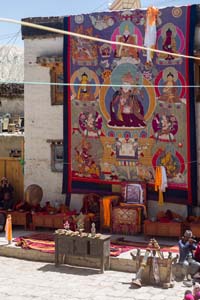
Camera Treks - What to Bring

Upper Mustang, Nepal
By Photographers – For Photographers!
May 2023
|
In photography negative space often has as much to say as the central focus of your image. Please read this important Preparations page after you read this one!  Travel Paperwork
Travel PaperworkAll travelers must have a valid passport at the time of their entry into Nepal. It should be valid for at least 6 months beyond the last day of your stay and have at least TWO blank pages (for country entrance & exit stamps.) Bring at least five visa/passport-style size photos. You will need two for your Nepal visa, one if you wish to buy a cell SIM card and another two for the Upper Mustang Restricted Area Permit. Make a color copy on good, stout paper, of the photo page of your passport to carry with you. It will serve as ID pretty much everywhere except for changing money at a bank. Comfortable clothes that you can get dirty and that are easy to wash in a sink or shower are a must! Quick-drying (a relative term) fabrics are best. There are no laundromats in Upper Mustang; a washerwoman is the only recourse. Your clothes will be soaped and beaten in a stream used by horses, yaks, goats, sheep and people for ALL their needs! I have had clothes washed this way and they do get clean but lots of sand needs to be shaken out of the fabric. Nights will be cold and days will get up to (probably) 64F/18C. This necessitates a variety of clothing. Layering is key. A sweater or light wind-proof jacket that you can tie around your waist or wear over the shoulder as the day warms is a good idea. With the walking we do good socks are a necessity. Shoes. We will be walking a lot. Every day. If you ordinarily wear tennis shoes that is fine once we are in Lo Manthang (and, of course, Kathmandu and the other larger towns) but remember you will also need footwear that provides good support to not only carry any luggage but that gives adequate support on trails. I often wear clogs for flights and in towns because they can look a bit dressy and also give good support. On trails, however, I always wear good hiking boots. You will not need dress shoes unless you are extending your trip and have more formal activities in mind. Clothes that bring attention to your person are not a good idea for any street or travel photography. You are trying to be unobtrusive and, as much as possible, blend in with your environment and those around you. For women, the shortest of shorts may be your thing, but will bring (perhaps) unwanted attention from locals and other travelers. Also, such attire on both men and women will block you from entering many of the monasteries that are such a part of these Buddhist environments. Dress appropriately. If you are a light sleeper BRING EARPLUGS and EYE SHADES. You may not need them but in some places your neighbors may arise in the early, dark hours to have breakfast and set out on their treks. We will be at high altitudes in Upper Mustang where the radiation load is substantial. If you are prone to sunburn please bring a hat, watch cap or some other headcover that you can use with a camera. My travel kit includes the all-important buff. A buff is a textile tube you can pull over your head to cover your mouth and nose to filter out the ample talc-fine dust we will encounter every day. While large, hard-sided luggage is great for hauling loads of things in urban, modern, international air travel, it can a problem on the small jets/prop planes in use between Kathmandu and Pokhara and Jomsom. If you feel you must use this type of luggage you will need to buy some soft or smaller or duffle bags in Kathmandu. Large, maximum size luggage may not fit on some of the smaller aircraft and for sure, it will not fit in our SUV! For about $2 per day storage I can probably arrange for such bags to be stored at our Kathmandu hotel (assuming you are returning to Kathmandu.) Bring a circa 35mm or wider lens. You will want to get close, perhaps uncomfortably so. But this is a technique we will tackle on the tour. A long-ish lens may also be useful to compress views or for wildlife. With any luck we may see the famous wild blue sheep grazing on mountain hillsides! Accessories: Plenty of SD/CF cards, cable release, extra camera batteries, filters, 3-way adapter plug, multi-outlet strip, power cords, etc. Some kind of air blower and cleaning cloths will really come in handy. The blowing dust level in Nepal is extraordinary! Sensor wipes are also a good idea. More specifics will be in your Tour CD. DO NOT plan on buying any camera stuff in Nepal. Pack what you need, including batteries! Maybe: Dessicant like silica-gel, in a dry zip-lock for drying out the camera if it gets wet. Perhaps a plastic bag of some sort with a cut-out for the lens and rubber bands to hold all in place (in case it rains and you want to take photos in that rain.) I carry two camera bodies while traveling in case one has a problem. This is not necessary but.... While a bit of a hassle for weight and security, a laptop computer with your chosen software can be handy. You can also use it to maintain contact with home or to upload to your social media sites (if that is your thing.) NEW: electricity is now available in Upper Mustang! An electrical plug adapter with the proper configuration is usually necessary. The system is 220-240 volts. Fortunately, all modern cell phones and computers are usually able to accept both this and the U.S. standard 110 volts. I carry a travel hard drive. Your photos should ALWAYS be stored in at least two places while you travel. It is a good idea to put your fully used SD/CF cards away and use empty ones for your next shots. If you plan on downloading your SD/CF cards soon after use, with the intention of erasing them to use over on the trip, you are engaging in a perfect recipe for disaster. More on this in your Tour CD. Obviously, any medications you use on a regular basis. Keep them in the original container with the prescription on the label. Some products and over-the-counter remedies may be hard to find in Kathmandu, impossible in Mustang where there are no doctors, no pharmacies, no stores. Be sure you have an adequate supply for the length of the trip PLUS the travel days! Bring products you may need for headaches, allergies, colds, menstrual symptoms, etc. We are traveling late winter - early spring. Still, the sun can scorch. Bring sunscreen and a decent hat or buy one in Kathmandu (that you can wear while taking pictures) if you are prone to burning. Lo, the capital of Upper Mustang, is 3840 meters/ 12, 598 feet altitude and the whole region is in the rain shadow of the Annapurna and Dhaulagiri ranges. It is cool and semi-arid with 250-400mm / 10-16 inches of precipitation each year. I carry a $5 plastic poncho that folds up into a tiny package but have never used it (even tho I have encountered light drizzle once or twice.) If you are particular about your sleeping pillow pack an inflatable one. Pillows at most teahouses in Mustang come in two flavors: non-existent or sucky. You will not find healthy, tasty snacks in Mustang. If you are a snack person bring your own granola bars, nuts, trail mix, etc. If you have special dietary needs talk to me before we go! Some items to consider:
Face cloth, shampoo, conditioner, hairspray, comb, hair brush (avoid hair dryers and irons) If you bring more than the equivalent of $5,000 USD in cash, you are supposed to declare it at Customs. It is not easy to spend much money/cash in Mustang - unless you wish to stay at the $400+ per night new lodge in Lo Manthang. In Kathmandu they are used to tourists - and used to fleecing them. As such, vendors have perfected their sales techniques. While there is not an overflow of many of the standard items many people are used to seeing (cameras, digital devices, etc.) there is much fine art. No, not the cheesy stuff one finds everywhere in the world (tho that exists, too) but great Buddhist paintings and sculpture, much of it sold by the artists who created it. Do bargain – but in a friendly and nice manner! And, if you do bargain, be sure the item is really something you plan on buying if you can reach a genuine price agreement. Nothing infuriates a seller more than coming to a good price agreement only to have the potential buyer then say, "OK, I'll think about it." When you change money at a legal money exchange or bank you may be required to show your passport, not a copy. Get a receipt of the transaction. It may be better to make several exchanges as needed in Kathmandu (depending on how long you stay) rather than changing a whopping amount all at once as there are transaction fees on either end, that is, when you change your Nepal rupees back into your home currency! You will need your passport to buy a SIM cell card, too.
There are ATM machines in the cities (3% fees), NONE in Upper Mustang. Credit cards are readily accepted in cities but they will most like add a percentage to cover their fees. Do not let your card out of your sight. Tipping for Service. You will be tipping in cities for service, taxis, and food. But people seem to be happy with 10% or less, depending on the service. Gifts are optional but anyone you encounter will appreciate the thought – and the gift! Doling out money in the cities to folks in the street and pan-handlers is not recommended; many of these individuals are professional scam 'artists'. Begging is uncommon in Mustang, tho, alas, children are learning to ask for chocolate and sweets now that the road is finished and snacks and sodas are flooding the land.
Moleskin book or similar notepad Maps. Unless the map you already own is Excellent you can find all the great maps you need a few steps away from our Kathmandu hotel. Plus, there are bookstores all over Thamel District! Expired medicines Fresh food, live plants or seeds Drugs, other than legal pharmaceuticals. Do not put your tour companions and yourself in jeopardy. Long-term prison sentences are common for making a silly (and serious) mistake! Leave all narcotics, explosives, pornography, anti-Chinese literature and weapons at home! Want to be a better photographer? All images and text © 2015-2023 Coup de Foudre, LLC & Camera Treks
Home
All Tours
Contact
|